Well Placement Optimization through the Triple-Completion Gas and Downhole Water Sink-Assisted Gravity Drainage (TC-GDWS-AGD) EOR Process
Abstract
:1. Introduction
2. TC-GDWS-AGD Well Configurations
3. PUNQ-S3 Truth Case Description
4. TC-GDWS-AGD Simulation Applied to PUNQ-S3 Reservoir
5. Well Placement Optimization
6. Particle Swarm Optimization
7. Summary and Conclusions
- The effectiveness of the TC-GDWS-AGD enhanced oil recovery (EOR) technique was confirmed by this simulation study in terms of its ability to increase oil recovery and decrease water cut compared with applying gas-assisted gravity drainage (GAGD) and gas-downhole water sink (GDWS) EOR processes to the Punq-S3 synthetic reservoir.
- The TC-GDWS-AGD completions are effective in reducing water cut and increasing cumulative oil production. Cumulative oil was increased from 1.47 × 106 m3 from the primary process to 1.6 × 106 m3 from the best TC-GDWS-AGD case with an oil recovery factor of 0.58, whereas water cut decreased from 70% in the GAGD process to 57% in the best TC-GDWS-AGD case.
- As the TC-GDWS-AGD gas-injection rate was enhanced from 350,000 m3 to 500,000 m3, the water cut decreased from 0.57 to 0.50. When the maximum surface-water-production rate (STW) constraint was raised to 20,000 m3/day, the PSO algorithm was able to find locations that achieved high oil recovery with the lowest overall water cut (0.45) for the two-TC-well cases.
- The PSO algorithm was highly effective at identifying the optimum well completion locations for maximizing oil recovery and minimizing water cut in the studied reservoir. To achieve maximum reservoir coverage, for each simulated scenario, one well completion was placed to the right side of a surface location and one well to the left side.
- The gas injection rate (STG) had only a minor impact on oil recovery volumes because the permeability of the reservoir layer two was very low. In fact, the transfer of gas from reservoir layer one to reservoir layer three was found to decrease as the gas injection rate increased.
Author Contributions
Funding
Data Availability Statement
Conflicts of Interest
References
- Al-Azmi, N.H.; Aladwani, F.A.; Kasaraneni, P.R. Water Control Management Utilizing Downhole Water Sink Technology: Application of a Reservoir in the Middle East. In Proceedings of the SPE Kuwait Oil & Gas Show and Conference, Kuwait City, Kuwait, 16 October 2017. [Google Scholar] [CrossRef]
- Al-Mudhafar, W.J.; Rao, D. Lessons learned from the field-scale simulation of the gas-assisted gravity drainage GAGD process in heterogeneous sandstone oil reservoirs. In Proceedings of the SPE Western Regional Meeting, Bakersfield, CA, USA, 23–27 April 2017. [Google Scholar] [CrossRef]
- Rao, D.; Ayirala, S.; Kulkarni, M.; Sharma, A. Development of gas assisted gravity drainage (GAGD) process for improved light oil recovery. In Proceedings of the SPE/DOE Symposium on Improved Oil Recovery, Tulsa, OK, USA, 17–21 April 2004. [Google Scholar] [CrossRef]
- Al-Mudhafar, W.J.; Rao, D.N.; Srinivasan, S.; Wood, D.A. Bayesian averaging sensitivity analysis of reservoir heterogeneity and anisotropy of carbon dioxide assisted gravity drainage of a large clastic oil reservoir. Fuel 2023, 337, 127200. [Google Scholar] [CrossRef]
- Gugl, R.; Kharrat, R.; Shariat, A.; Ott, H. Evaluation of Gas-Based EOR Methods in Gas-Invaded Zones of Fractured Carbonate Reservoir. Energies 2022, 15, 4921. [Google Scholar] [CrossRef]
- Sorokin, A.; Bolotov, A.; Varfolomeev, M.; Minkhanov, I.; Gimazov, A.; Sergeyev, E.; Balionis, A. Feasibility of Gas Injection Efficiency for Low-Permeability Sandstone Reservoir in Western Siberia: Experiments and Numerical Simulation. Energies 2021, 14, 7718. [Google Scholar] [CrossRef]
- Al-Ghanim, W.; Gharbi, R.; Algharaib, M.K. Designing a simultaneous water alternating gas process for optimizing oil recovery. In Proceedings of the SPE EUROPEC/EAGE Conference and Exhibition, Amsterdam, The Netherlands, 8–11 June 2009. [Google Scholar] [CrossRef]
- Mahmoud, T.N.; Rao, D.N. Mechanisms and Performance Demonstration of the Gas-Assisted Gravity-Drainage Process Using Visual Models. In Proceedings of the SPE Annual Technical Conference and Exhibition, Anaheim, CA, USA, 11–14 November 2007. [Google Scholar] [CrossRef]
- Vo Thanh, H.; Sugai, Y.; Nguele, R.; Sasaki, K. Robust Optimization of CO2 Sequestration through a Water Alternating Gas Process under Geological Uncertainties in Cuu Long Basin, Vietnam. J. Nat. Gas Sci. Eng. 2020, 76, 103208. [Google Scholar] [CrossRef]
- Munawar, M.D.; Rao, D.; Khan, M. Evaluation of Gas Assisted Gravity Drainage (GAGD) Using CO2 in a Limestone Formation through Compositional Simulation. In Proceedings of the SPE/PAPG Pakistan Section Annual Technical Conference and Exhibition, Islamabad, Pakistan, 22–23 November 2017. [Google Scholar] [CrossRef]
- Baruah, N.; Mandal, D.; Jena, S.S.; Sahu, S.K. Gas Assisted Gravity Drainage GAGD for Improving Recovery from a Field in North-East India. In Proceedings of the SPE Oil and Gas India Conference and Exhibition, Mumbai, India, 11 April 2019. [Google Scholar] [CrossRef]
- Al-Obaidi, D.A.; Al-Jawad, M.S. Immiscible CO2-Assisted Gravity Drainage Process for Enhancing Oil Recovery in Bottom Water Drive reservoir. Assoc. Arab. Univ. J. Eng. Sci. 2020, 27, 60–66. [Google Scholar] [CrossRef]
- Al-Mudhafar, W.J.; Rao, D.N. Proxy-based metamodeling optimization of the gas-assisted gravity drainage GAGD process in heterogeneous sandstone reservoirs. In Proceedings of the SPE Western Regional Meeting, Bakersfield, CA, USA, 23–27 April 2017. [Google Scholar] [CrossRef]
- Al-Mudhafar, W.J.; Al-Obaidi, D.A.; Saini, D.; Wojtanowicz, A.K.; Al-Jawad, M.S. Feasibility of the Gas and Downhole Water Sink-Assisted Gravity Drainage (GDWS-AGD) Process to Enhance the Recovery of Oil in Reservoirs with Strong Aquifer. In Macromolecular Characterization of Hydrocarbons for Sustainable Future. Green Energy and Technology; Springer: Singapore, 2021; pp. 91–106. [Google Scholar] [CrossRef]
- Al-Obaidi, D.A.; Al-Mudhafar, W.J.; Al-Jawad, M.S. Experimental evaluation of Carbon Dioxide-Assisted Gravity Drainage process (CO2-AGD) to improve oil recovery in reservoirs with strong water drive. Fuel 2022, 324, 124409. [Google Scholar] [CrossRef]
- Al-Mudhafar, W.J.; Rao, D.N.; Srinivasan, S.; Thanh, H.V.; Al Lawe, E.M. Rapid Evaluation and Optimization of Carbon Dioxide-enhanced Oil Recoveryusing Reduced-physics Proxy Models. Energy Sci. Eng. 2022, 10, 4112–4135. [Google Scholar] [CrossRef]
- Al-Mudhafar, W.J.; Wojtanowicz, A.K.; Rao, D.N. Hybrid Process of Gas and Downhole Water Sink-Assisted Gravity Drainage (G&DWS-AGD) to Enhance Oil Recovery in Reservoirs with Water Coning. In Proceedings of the Carbon Management Technology Conference, Houston, TX, USA, 17–20 July 2017. [Google Scholar] [CrossRef]
- Al-Mudhafar, W.J.; Wojtanowicz, A.K.; Rao, D.N. Gas and Downhole Water Sink-Assisted Gravity Drainage GDWS-AGD EOR Process: Field-Scale Evaluation and Recovery Optimization. In Proceedings of the SPE Improved Oil Recovery Conference, Tulsa, OK, USA, 18 April 2018. [Google Scholar] [CrossRef]
- Al-Mudhafar, W.J.; Wojtanowicz, A.K. A Comparison Simulation Study of GDWS-AGD EOR Process Performance Using CO2/APG Alternatives in South Rumaila Oil Field, Iraq. In Proceedings of the SPE Improved Oil Recovery Conference, Tulsa, Oklahoma, USA, 31 August–4 September 2020. [Google Scholar] [CrossRef]
- Al-Obaidi, D.A.; Al-Jawad, M.S. Numerical Simulation of Immiscible CO2-Assisted Gravity Drainage Process to Enhance Oil Recovery. Iraqi J. Sci. 2020, 61, 2004–2016. [Google Scholar] [CrossRef]
- Jupriansyah, J. An Integrated Study of Water Coning Control with Downhole Water Sink Completion Approaches in Multilayered-Strong Water Drive Reservoir to Improve Oil Recovery. In Proceedings of the SPE Oil and Gas India Conference and Exhibition, Mumbai, India, 20–22 January 2010. [Google Scholar] [CrossRef]
- Rajabi-Kochi, M.; Khamehchi, E. Integrated production optimization of an oil field based on constructing of a proxy model using DOE methods. J. Pet. Explor. Prod. Technol. 2020, 10, 2465–2482. [Google Scholar] [CrossRef]
- Ding, S.; Lu, R.; Xi, Y.; Liu, G.; Ma, J. Efficient well placement optimization coupling hybrid objective function with particle swarm optimization algorithm. Appl. Soft Comput. 2020, 95, 106511. [Google Scholar] [CrossRef]
- Raji, S.; Dehnamaki, A.; Somee, B.; Mahdiani, M.R. A new approach in well placement optimization using metaheuristic algorithms. J. Pet. Sci. Eng. 2022, 215, 110640. [Google Scholar] [CrossRef]
- Yousefzadeh, R.; Ahmadi, M.; Kazemi, A. Toward investigating the application of reservoir opportunity index in facilitating well placement optimization under geological uncertainty. J. Pet. Sci. Eng. 2022, 215, 110709. [Google Scholar] [CrossRef]
- Arouri, Y.; Ciaurri, D.E.; Sayyafzadeh, M. A study of simulation-based surrogates in well-placement optimization for hydrocarbon production. J. Pet. Sci. Eng. 2022, 216, 110639. [Google Scholar] [CrossRef]
- Zou, A.; Ye, T.; Volkov, O.; Durlofsky, L.J. Effective treatment of geometric constraints in derivative-free well placement optimization. J. Pet. Sci. Eng. 2022, 215, 110635. [Google Scholar] [CrossRef]
- Salehian, M.; Sefat, M.H.; Muradov, K. Multi-solution well placement optimization using ensemble learning of surrogate models. J. Pet. Sci. Eng. 2022, 210, 110076. [Google Scholar] [CrossRef]
- Zoeir, A.; Riazi, M.; Kazemzadeh, Y.; Khodapanah, E. To optimize well pattern during miscible gas injection process via heuristic techniques. J. Pet. Sci. Eng. 2022, 208, 109786. [Google Scholar] [CrossRef]
- Montes, G.; Bartolome, P.; Udias, A.L. The use of genetic algorithms in well placement optimization. In Proceedings of the SPE Latin American and Caribbean petroleum engineering conference, Buenos Aires, Argentina, 25–28 March 2001. [Google Scholar] [CrossRef]
- Yeten, B.; Durlofsky, L.J.; Aziz, K. Optimization of nonconventional well type, location, and trajectory. SPE J. 2003, 8, 200–210. [Google Scholar] [CrossRef]
- Lyons, J.; Nasrabadi, H. Well placement optimization under time-dependent uncertainty using an ensemble Kalman filter and a genetic algorithm. J. Pet. Sci. Eng. 2013, 109, 70–79. [Google Scholar] [CrossRef]
- Emerick, A.A.; Silva, E.; Messer, B.; Almeida, L.F.; Szwarcman, D.; Pacheco, M.A.C.; Vellasco, M.M.B.R. Well placement optimization using a genetic algorithm with nonlinear constraints. In Proceedings of the SPE Reservoir Simulation Symposium, The Woodlands, TX, USA, 2–4 February 2009. [Google Scholar] [CrossRef]
- Aliyev, E. Use of Hybrid Approaches and Metaoptimization for Well Placement Problems. Ph.D. Dissertation, Stanford University, Stanford, CA, USA, 2011. [Google Scholar]
- Humphries, T.D.; Haynes, R.D.; James, L.A. Simultaneous and sequential approaches to joint optimization of well placement and control. Comput. Geosci. 2014, 18, 433–448. [Google Scholar] [CrossRef]
- Rahman, I.; Vasant, P.; Singh, B.S.M.; Al-Wadud, A.M. Hybrid particle swarm and gravitational search optimization techniques for charging plug-in hybrid electric vehicles. In Sustainable Infrastructure: Breakthroughs in Research and Practice; IGI Global: Hershey, PA, USA, 2020; pp. 195–228. [Google Scholar] [CrossRef]
- Vo Thanh, H.; Zamanyad, A.; Safaei-Farouji, M.; Ashraf, U.; Hemeng, Z. Application of Hybrid Artificial Intelligent Models to Predict Deliverability of Underground Natural Gas Storage Sites. Renew. Energy 2022, 200, 169–184. [Google Scholar] [CrossRef]
- Morales, A.; Nasrabadi, H.; Zhu, D. A modified genetic algorithm for horizontal well placement optimization in gas condensate reservoirs. In Proceedings of the SPE Annual Technical Conference and Exhibition, Florence, Italy, 20–22 September 2010. [Google Scholar] [CrossRef]
- Chang, Y.; Bouzarkouna, Z.; Devegowda, D. Multi-objective optimization for rapid and robust optimal oilfield development under geological uncertainty. Comput. Geosci. 2015, 19, 933–950. [Google Scholar] [CrossRef]
- Saikia, B.D.; Rao, D.N. A Single-Well Gas-Assisted Gravity Drainage Enhanced Oil Recovery Process for US Deepwater Gulf of Mexico Operations. Energies 2021, 14, 1743. [Google Scholar] [CrossRef]
- Al-Tammimi, M.A.; Al-Maliki, S.Y.; Alabody, M.J.; Al-Mudhafar, W.J.; Wood, D.A.; Wojtanowicz, A.K. Development of A Multi-Completion-Gas and Downhole Water Sink-Assisted Gravity Drainage MC-GDWS-AGD Process to Enhance Oil Recovery and Reduce Water Cresting in Reservoirs with Strong Water Aquifers. In Proceedings of the Offshore Technology Conference, Houston, TX, USA, 5 May 2022. [Google Scholar] [CrossRef]
- Al-Obaidi, D.A.; Wood, D.A.; Al-Mudhafar, W.J.; Wojtanowicz, A.K.; Merzoug, A. Development of A Multi-Completion-Gas and Downhole Water Sink-Assisted Gravity Drainage (MC-GDWS-AGD) Process to Improve Oil Recovery and Reduce Water Cut in Reservoirs with Strong Water Aquifers. In Proceedings of the SPE Oklahoma City Oil and Gas Symposium, Oklahoma City, OK, USA, 17–19 April 2023. [Google Scholar] [CrossRef]
- Floris, F.J.T.; Bush, M.D.; Cuypers, M.; Roggero, F.; Syversveen, A.-R. Methods for quantifying the uncertainty of production forecasts: A comparative study. Pet. Geosci. 2001, 7, S87–S96. [Google Scholar] [CrossRef]
- Hutahaean, J.; Demyanov, V.; Christie, M. Reservoir development optimization under uncertainty for infill well placement in brownfield redevelopment. J. Pet. Sci. Eng. 2019, 175, 444–464. [Google Scholar] [CrossRef]
- Roque, W.L.; Araújo, C.P. Production simulations based on a productivity potential proxy function: An application to UNISIM-I-D and PUNQ-S3 synthetic reservoirs. J. Petrol. Explor. Prod. Technol. 2021, 11, 399–410. [Google Scholar] [CrossRef]
- CMG. Manual of the Computer Modeling Group’s Reservoir Flow Simulator; Version 2015.10; CMG: Calgary, AB, Canada, 2015. [Google Scholar]
- Onwunalu, J.E.; Durlofsky, L.J. Application of a particle swarm optimization algorithm for determining optimum well location and type. Comput. Geosci. 2010, 14, 183–198. [Google Scholar] [CrossRef]
- Sayyad, H.; Manshad, A.K.; Rostami, H. Application of hybrid neural particle swarm optimization algorithm for prediction of MMP. Fuel 2014, 116, 625–633. [Google Scholar] [CrossRef]
- Ansari, E.; Hughes, R.; White, C.D. Well placement optimization for maximum energy recovery from hot saline aquifers. In Proceedings of the Thirty-Ninth Workshop on Geothermal Reservoir Engineering, Stanford, CA, USA, 24–26 February 2014; Available online: https://pangea.stanford.edu/ERE/pdf/IGAstandard/SGW/2014/Ansari.pdf (accessed on 1 December 2022).
- Atashnezhad, A.; Wood, D.A.; Fereidounpour, A.; Khosravanian, R. Designing and optimizing deviated wellbore trajectories using novel particle swarm algorithms. J. Nat. Gas Sci. Eng. 2014, 21, 1184–1204. [Google Scholar] [CrossRef]
- Ebrahimi, A.; Khamehchi, E. Developing a novel workflow for natural gas lift optimization using advanced support vector machine. J. Nat. Gas Sci. Eng. 2016, 28, 626–638. [Google Scholar] [CrossRef]
- Al-Mudhafar, W.J. Polynomial and nonparametric regressions for efficient predictive proxy metamodeling: Application through the CO2-EOR in shale oil reservoirs. J. Nat. Gas Sci. Eng. 2019, 72, 103038. [Google Scholar] [CrossRef]
- Mohamed, L.; Christie, M.; Demyano, V. History matching and uncertainty quantification: Multiobjective particle swarm optimisation approach. In Proceedings of the SPE EUROPEC/EAGE Annual Conference and Exhibition, Vienna, Austria, 23–26 May 2011. [Google Scholar] [CrossRef]
- Eberhart, R.; Kennedy, J. A new optimizer using particle swarm theory. In Proceedings of the Sixth International Symposium on Micro Machine and Human Science, Nagoya, Japan, 4–6 October 1995. [Google Scholar]
- Reddicharla, N. Automation of Down-hole Completion Data Management Workflow and Visualization. In Proceedings of the Abu Dhabi International Petroleum Exhibition and Conference, Abu Dhabi, United Arab Emirates, 9–12 November 2015. [Google Scholar] [CrossRef]
- Dyer, S.; Brett, B. Technology Update: New Intelligent Completion System Enables Compartment-Level Control in Multilateral Wells. J. Pet. Technol. 2016, 68, 18–21. [Google Scholar] [CrossRef]





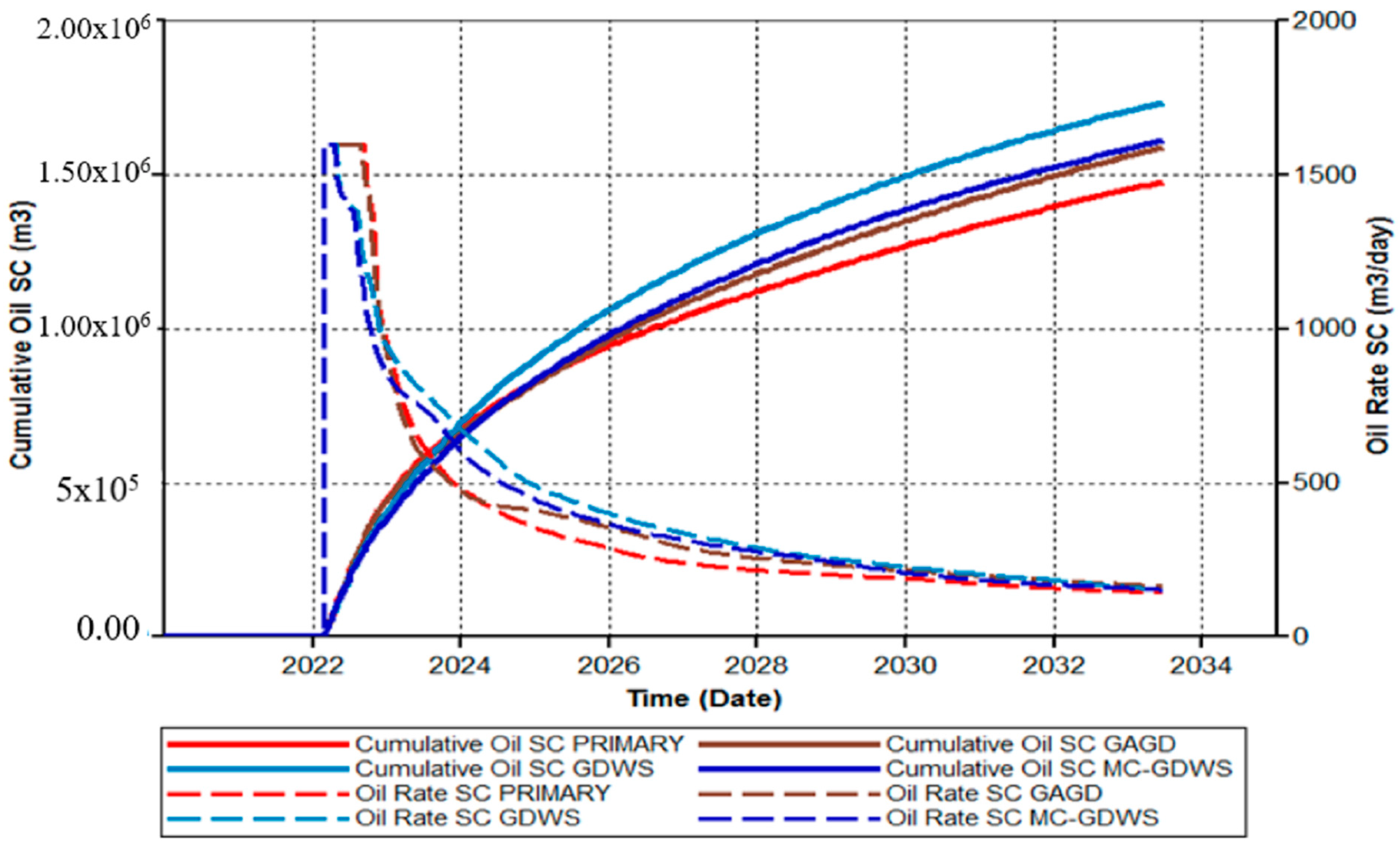
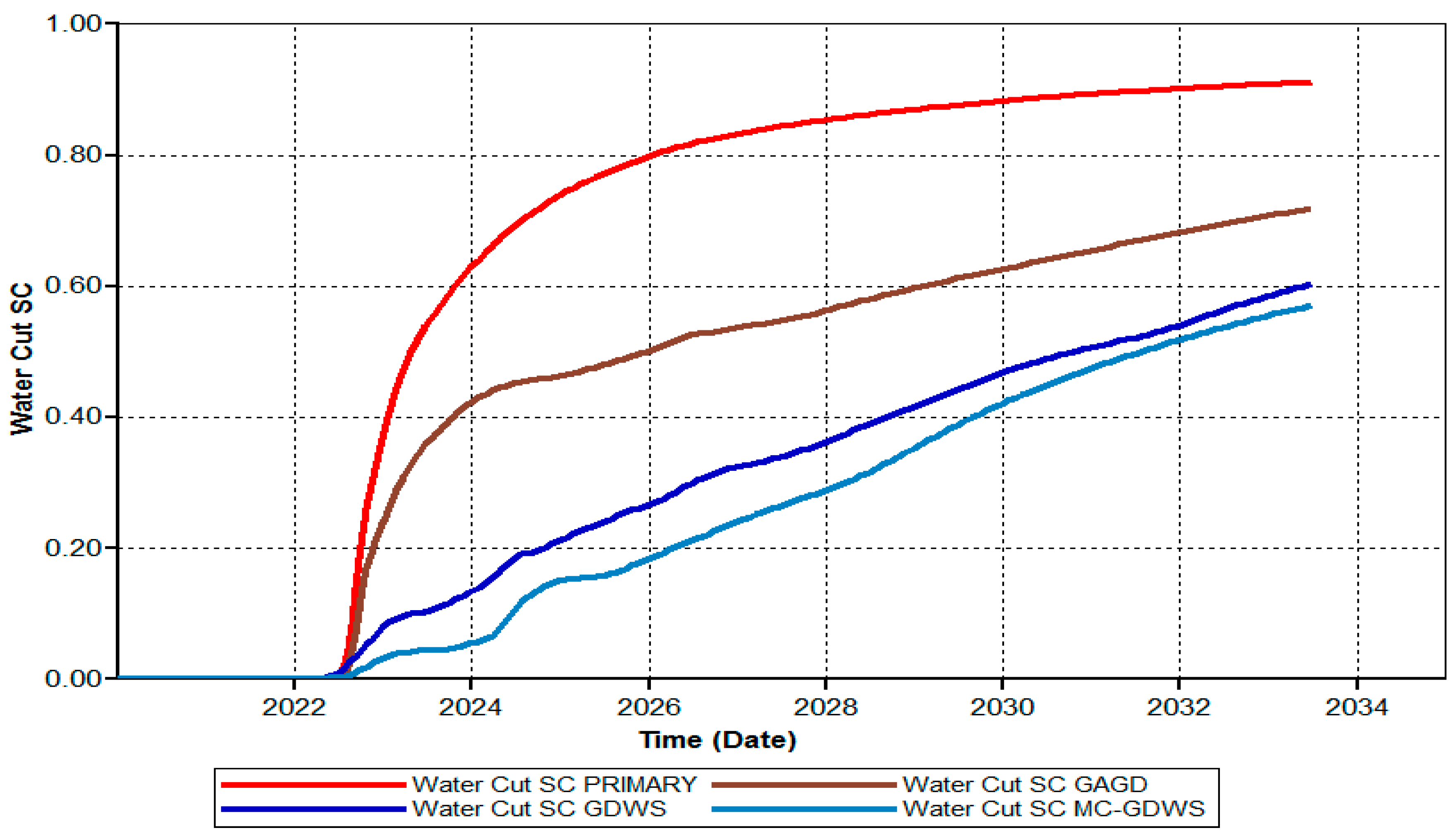
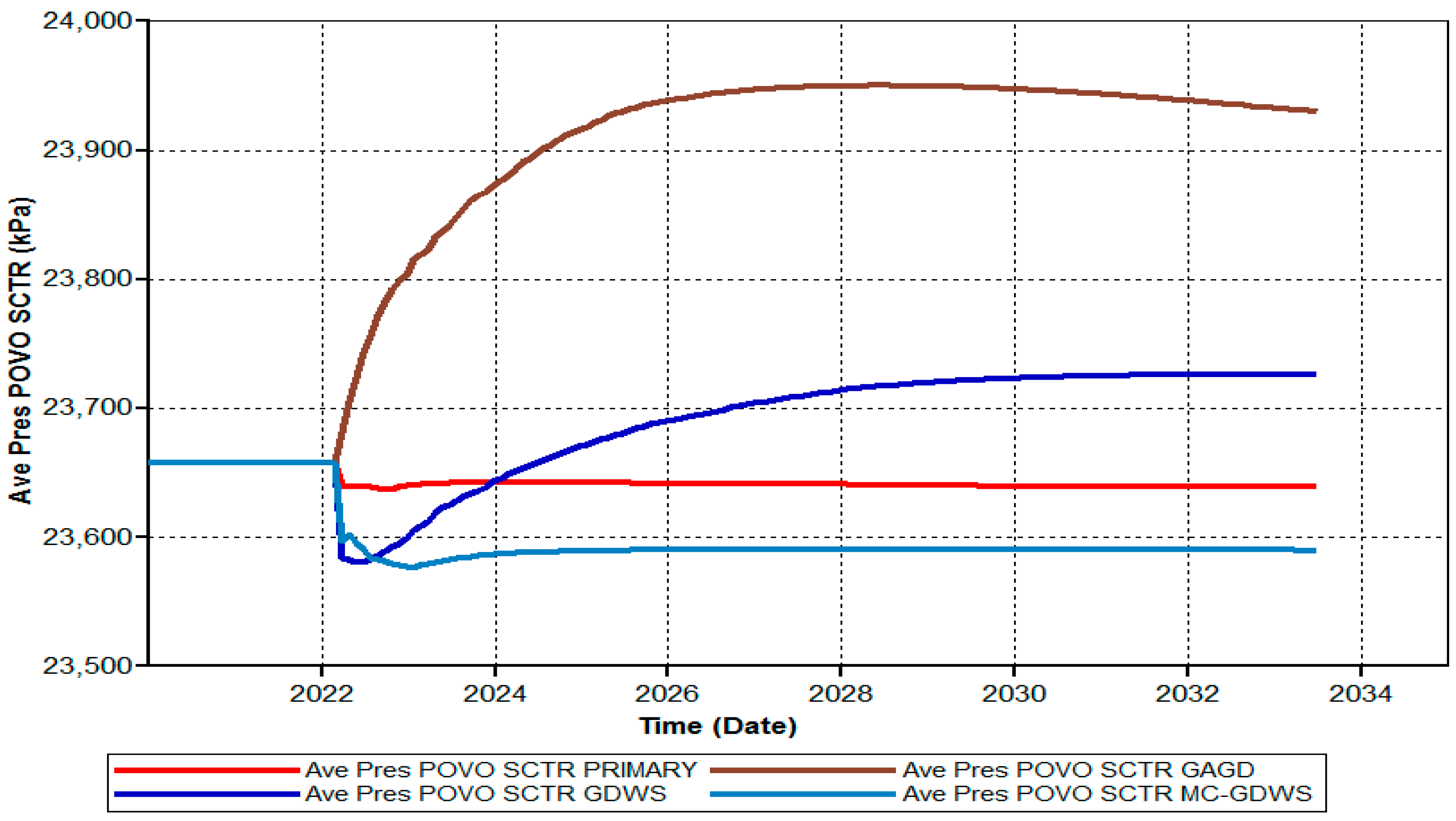
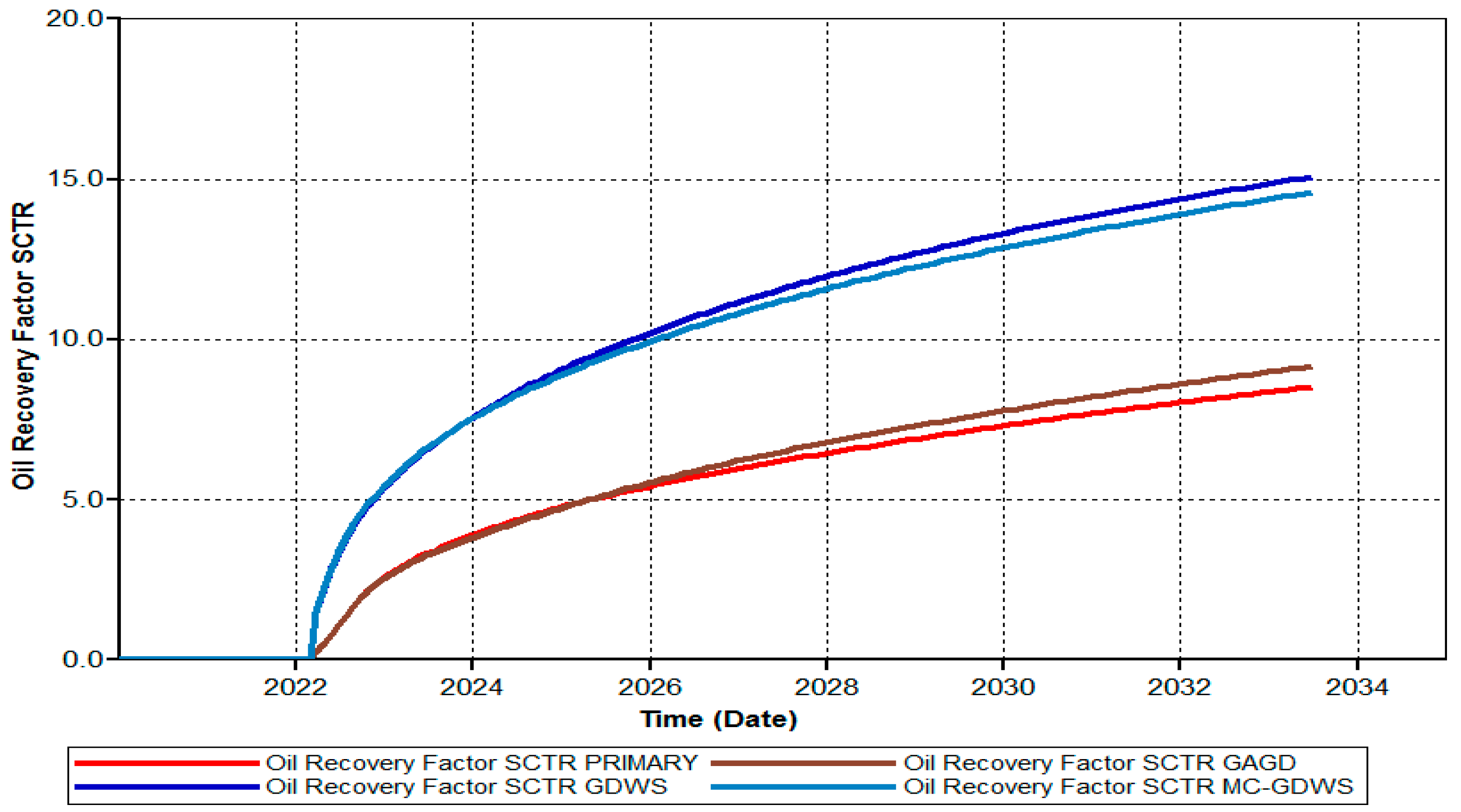

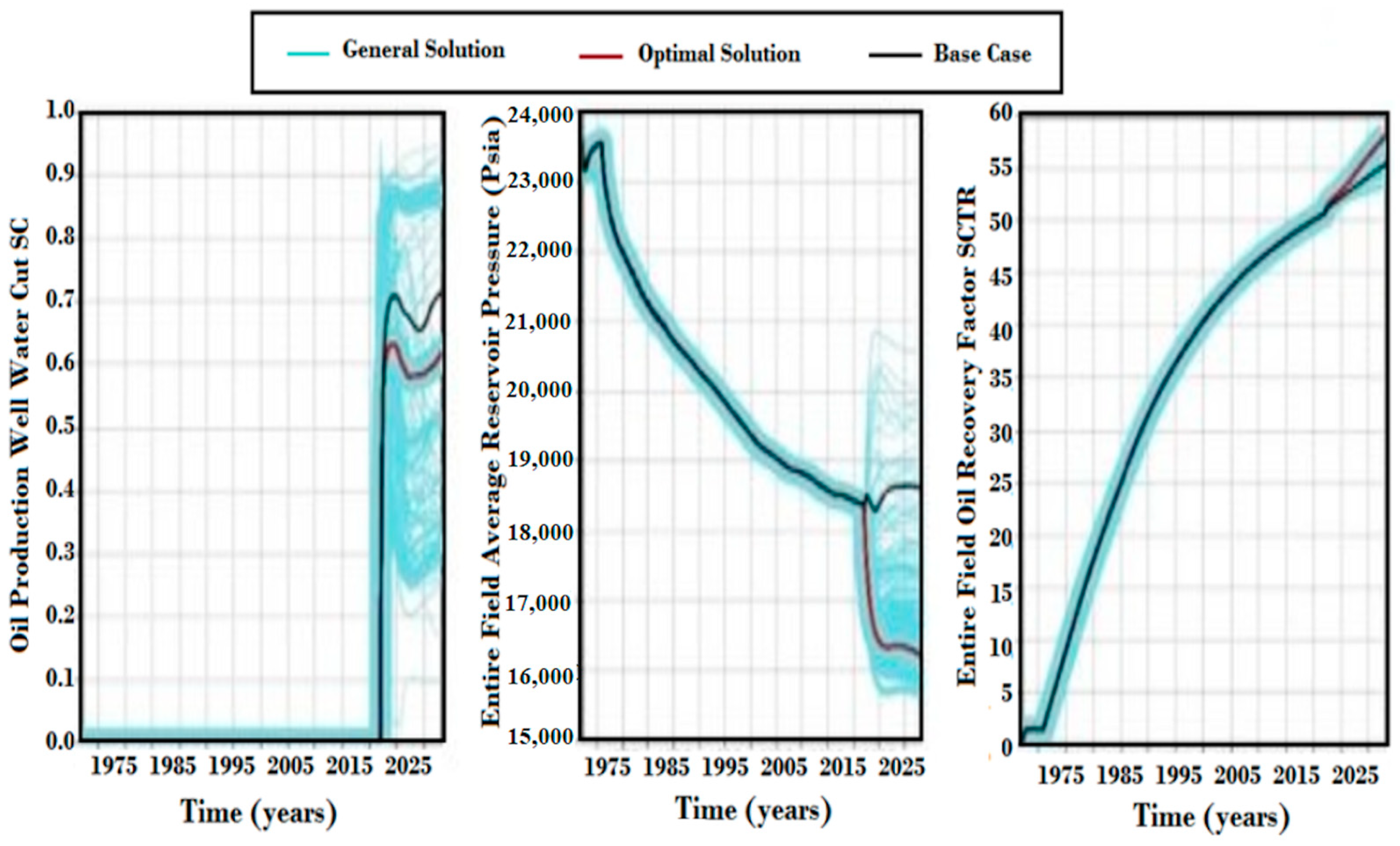
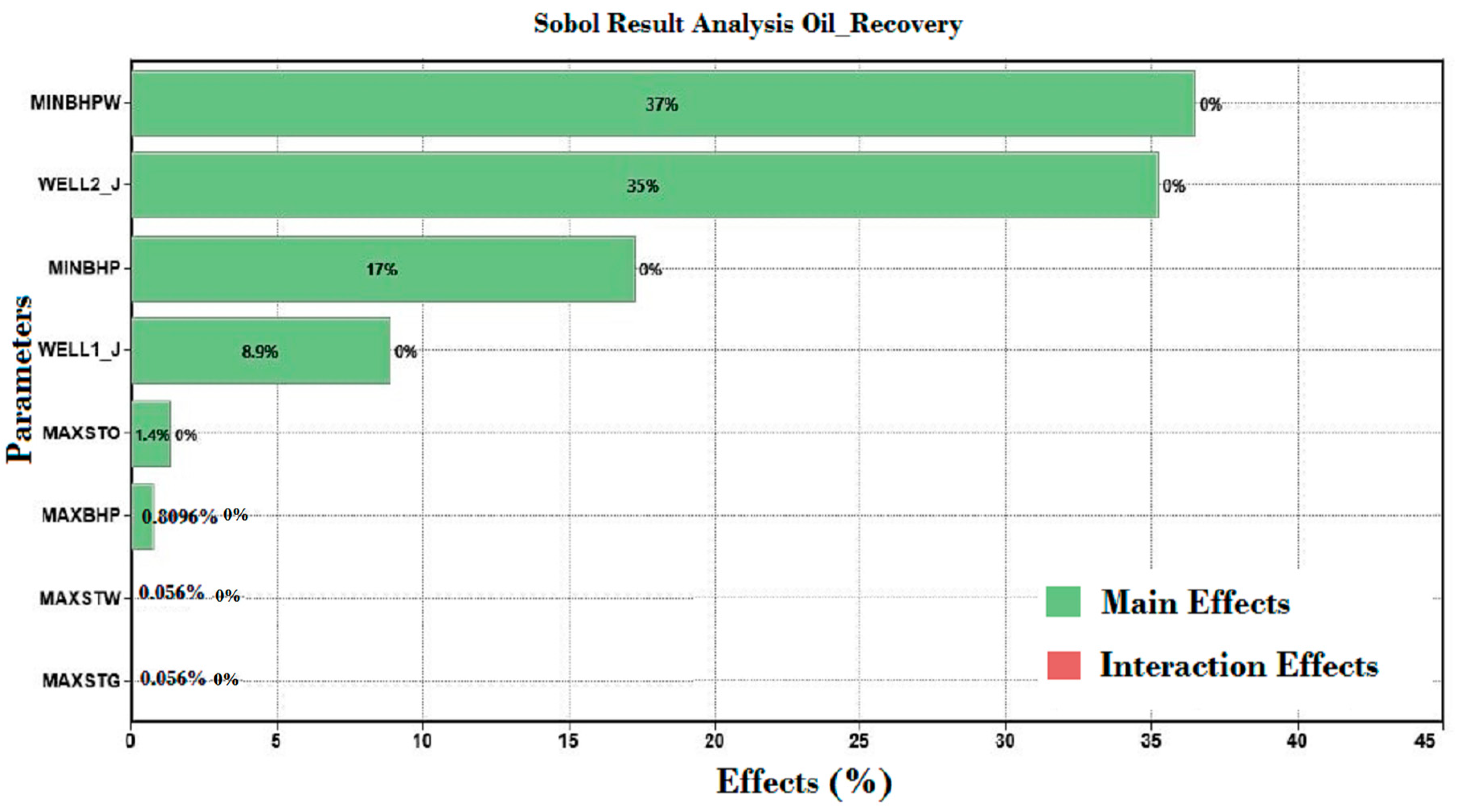
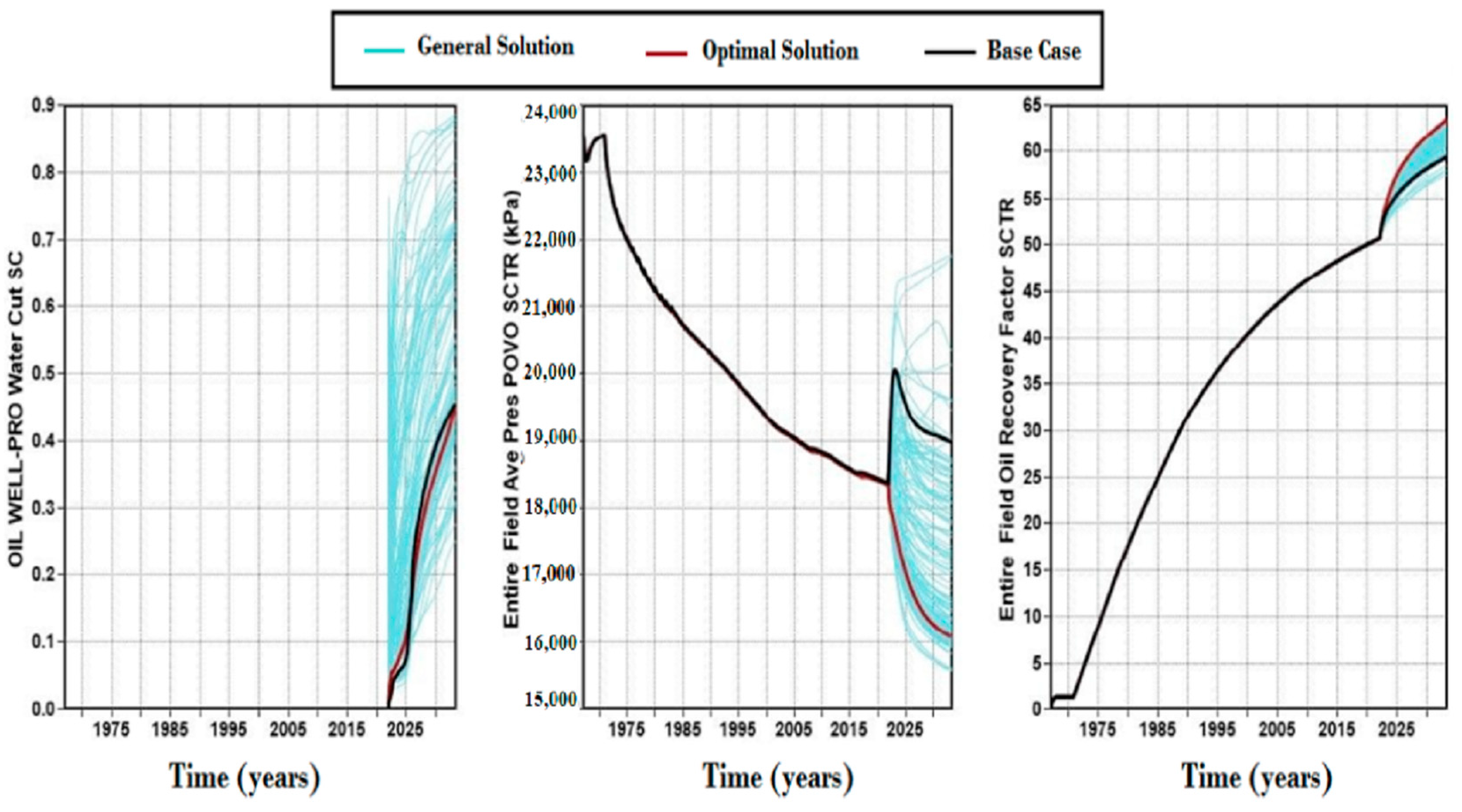
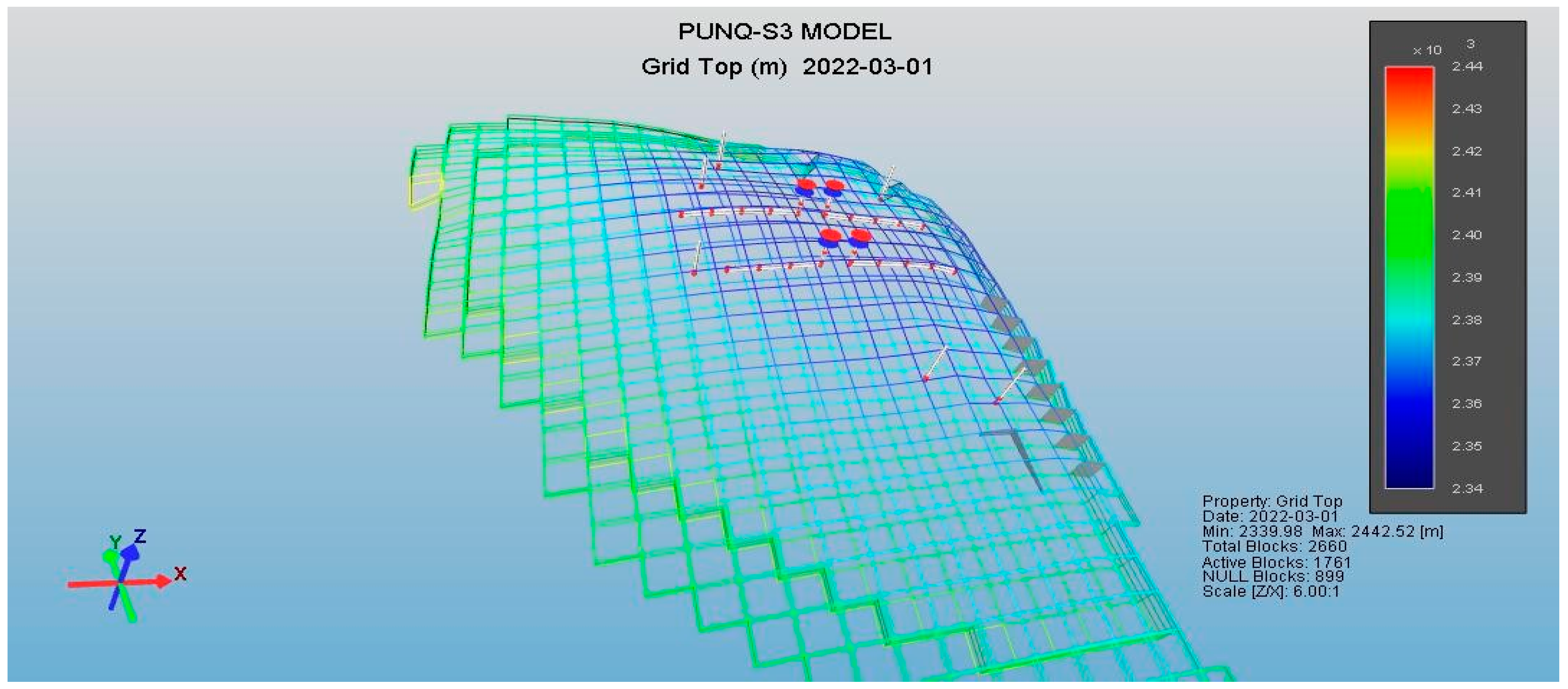
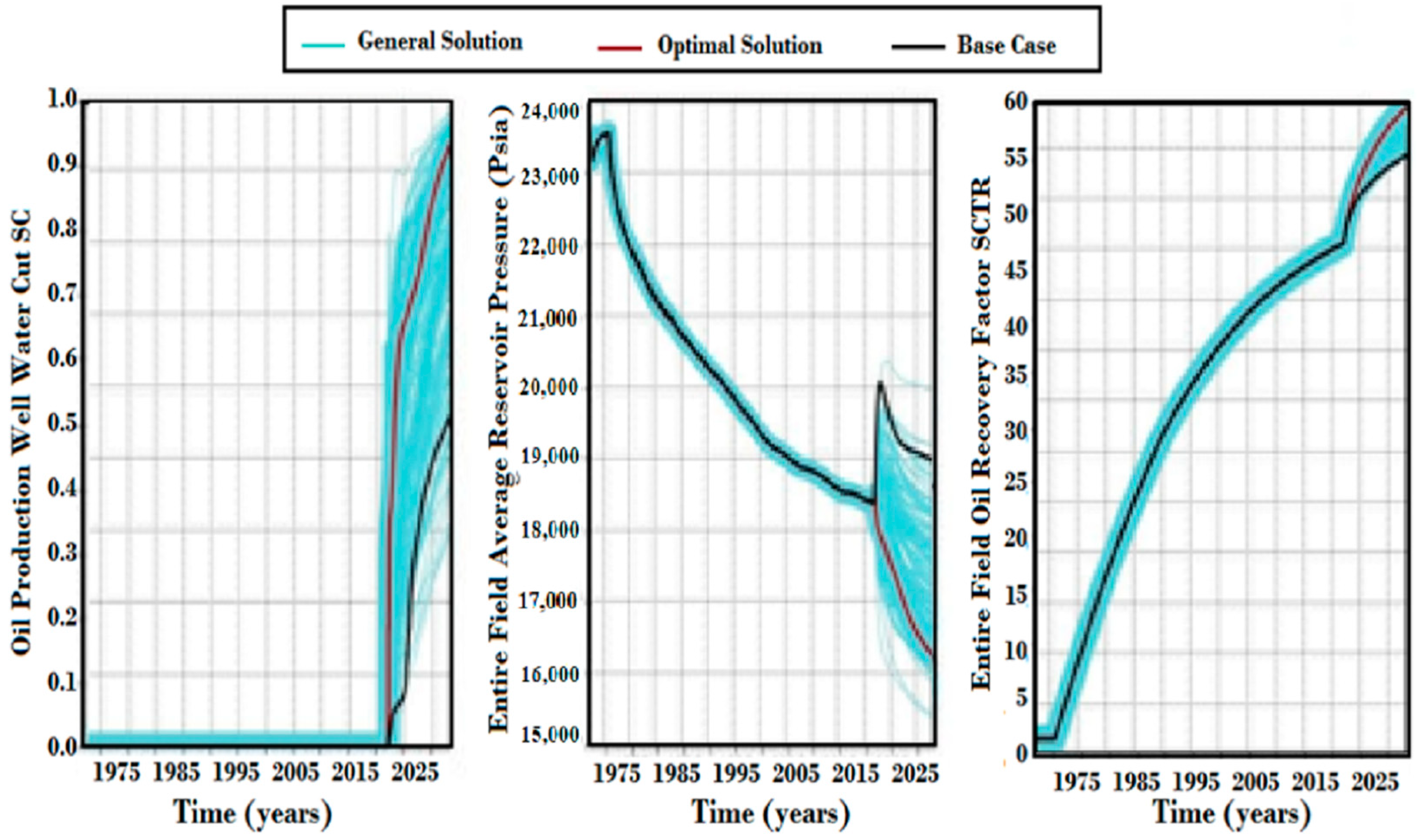
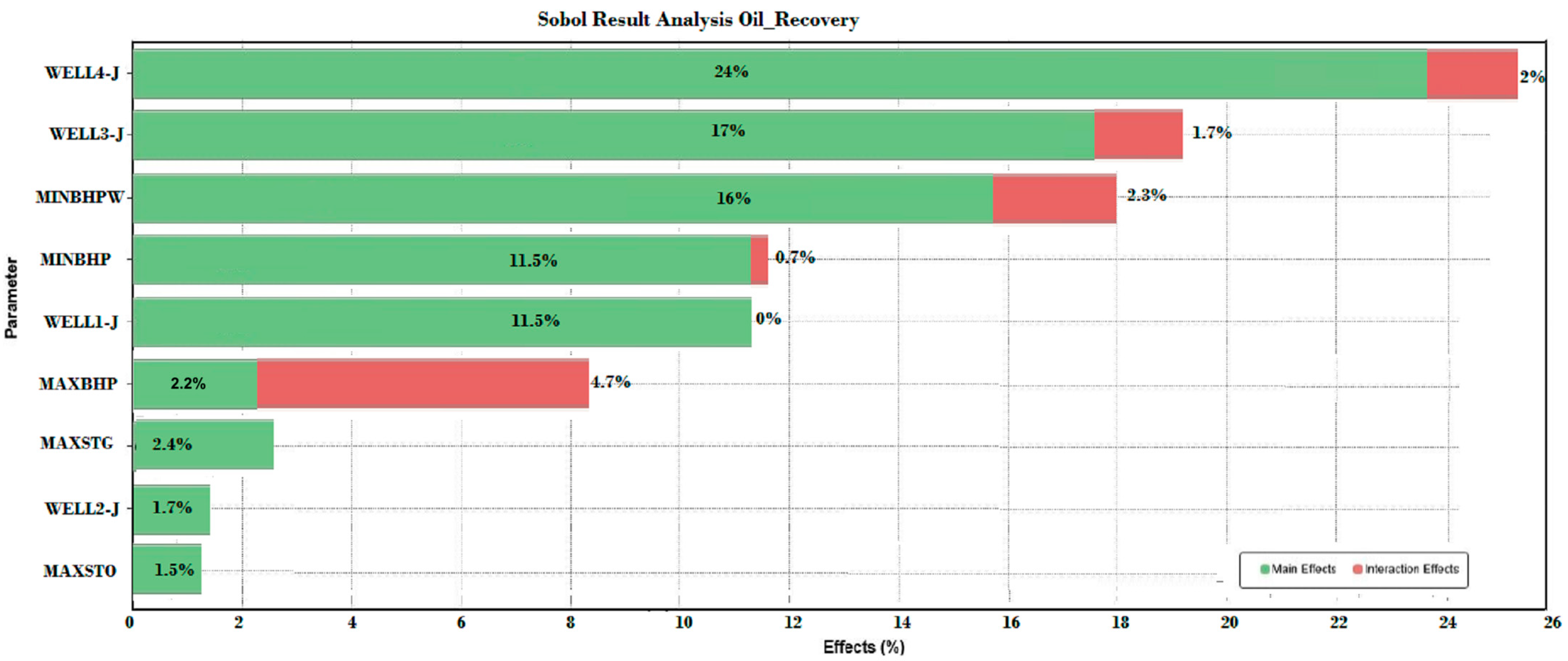
| Reservoir Characteristic | Reservoir Layer 1 | Reservoir Layer 2 | Reservoir Layer 3 | Reservoir Layer 4 | Reservoir Layer 5 |
|---|---|---|---|---|---|
| Average Porosity (ϕ%) | 0.17 | 0.08 | 0.17 | 0.16 | 0.19 |
| Average Horizontal Permeability (Kh mD) | 432 | 33 | 432 | 196 | 654 |
| Average Vertical Permeability(Kv mD) | 137 | 13 | 137 | 64 | 205 |
| Well Type | Constraints | TC-GDWS-AGD | GDWS-AGD | GAGD | Primary (Base Case) |
|---|---|---|---|---|---|
| Gas Injector | MAX STG | 350,000 m3/day | 350,000 m3/day | 350,000 m3/day | - |
| MAX BHP | 28,000 kpa | 28,000 kpa | 28,000 kpa | - | |
| Oil Producer | MAX STO | 800 m3/day | 800 m3/day | 800 m3/day | 800 m3/day |
| MIN BHP | 12,000 kpa | 12,000 kpa | 12,000 kpa | 12,000 kpa | |
| Water Producer | MAX STW | 3800 m3/day | 3800 m3/day | - | - |
| MIN BHP | 12,000 kpa | 12,000 kpa | - | - |
| PROCESS | TC-GDWS-AGD | GDWS | GAGD | PRIMARY |
|---|---|---|---|---|
| Oil Recovery | 14.5% | 15% | 9% | 8.5% |
| Water Cut | 57% | 60% | 70% | 90% |
| Decision Variables | Base Case TC-GDWS-AGD | Optimal Case TC-GDWS-AGD |
|---|---|---|
| Maximum Oil Production Rate (MAX_STO; m3/day) | 800 | 967.33 |
| Minimum Bottom Hole Pressure (Oil) (MIN_BHP; kpa) | 12,000 | 9533.48 |
| Maximum Gas Injection Rate (MAX_STG; m3/day) | 350,000 | 420,358.11 |
| Maximum Bottom Hole Pressure (Oil) (MAX_BHP; kpa) | 28,000 | 25,926.01 |
| Maximum Water Production Rate (MAX_STW, m3/day) | 3800 | 4424.58 |
| Minimum Bottom Hole Pressure (Water) MIN_BHPW, kpa | 12,000 | 9058.99 |
| Location of MC Well 1 (WELL 1_ J) | 20 | 22 |
| Location of MC Well 2 (WELL 2_J) | 20 | 19 |
| Parameters | Base Case | Optimum Case |
|---|---|---|
| MAX_STO, m3/DAY | 800 | 714.11 |
| MIN_BHP, kpa | 12,000 | 9031.55 |
| MAX_STG, m3/DAY | 350,000 | 325,512.06 |
| MAX_BHP, kpa | 28,000 | 26,894.18 |
| MIN_BHPW, kpa | 12,000 | 9065.37 |
| WELL 1_J | 20 | 23 |
| WELL 2_J | 20 | 20 |
| WELL 3_J | 17 | 14 |
| WELL 4_J | 17 | 17 |
Disclaimer/Publisher’s Note: The statements, opinions and data contained in all publications are solely those of the individual author(s) and contributor(s) and not of MDPI and/or the editor(s). MDPI and/or the editor(s) disclaim responsibility for any injury to people or property resulting from any ideas, methods, instructions or products referred to in the content. |
© 2023 by the authors. Licensee MDPI, Basel, Switzerland. This article is an open access article distributed under the terms and conditions of the Creative Commons Attribution (CC BY) license (https://creativecommons.org/licenses/by/4.0/).
Share and Cite
Al-Mudhafar, W.J.; Wood, D.A.; Al-Obaidi, D.A.; Wojtanowicz, A.K. Well Placement Optimization through the Triple-Completion Gas and Downhole Water Sink-Assisted Gravity Drainage (TC-GDWS-AGD) EOR Process. Energies 2023, 16, 1790. https://doi.org/10.3390/en16041790
Al-Mudhafar WJ, Wood DA, Al-Obaidi DA, Wojtanowicz AK. Well Placement Optimization through the Triple-Completion Gas and Downhole Water Sink-Assisted Gravity Drainage (TC-GDWS-AGD) EOR Process. Energies. 2023; 16(4):1790. https://doi.org/10.3390/en16041790
Chicago/Turabian StyleAl-Mudhafar, Watheq J., David A. Wood, Dahlia A. Al-Obaidi, and Andrew K. Wojtanowicz. 2023. "Well Placement Optimization through the Triple-Completion Gas and Downhole Water Sink-Assisted Gravity Drainage (TC-GDWS-AGD) EOR Process" Energies 16, no. 4: 1790. https://doi.org/10.3390/en16041790





